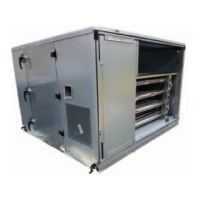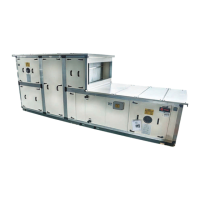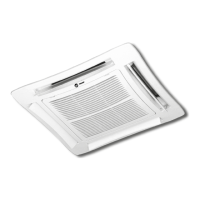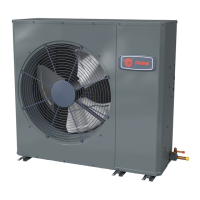Do you have a question about the Trane Climate Changer M Series and is the answer not in the manual?
Discusses the impact of certain chemicals on the ozone layer and Trane's stance.
Emphasizes the importance of certified technicians and adherence to refrigerant handling laws.
Warns about hazards associated with refrigerant systems and improper handling.
Warns against using improper gases for pressure testing, which can cause explosions.
Explains the purpose and safety considerations of factory-installed UV-C lights.
Warns against field-installation of UV lights due to material degradation and safety risks.
Details acceptable ambient temperature ranges for unit operation.
Describes the M-Series Climate Changer air handler's flexibility and modular construction.
Provides essential guidelines and warnings for electrical wiring installations.
Covers factory-mounted control systems and pre-packaged solutions.
Details requirements for power supply to factory-mounted control systems.
Lists resources available for commissioning and start-up of pre-packaged control solutions.
Outlines procedures for visually inspecting the unit upon receipt for shipping damage.
Describes where to find necessary assembly hardware and gasket material.
Provides instructions for reporting and handling units damaged during shipment.
Advises on protecting units from elements during storage before installation.
Specifies storage conditions for unit controllers and electrical components.
Details procedures for maintaining the unit during extended storage periods.
Outlines necessary steps to prevent damage when outdoor storage is unavoidable.
Covers site preparation, including weight support, space, and utility requirements.
Provides recommended clearance dimensions for unit service and maintenance.
Lists approximate module weights for single-wall construction unit sizes 3-25.
Lists approximate module weights for double-wall construction unit sizes 3-25.
Specifies maximum weight and length limits for single-piece unit shipments.
Explains how to calculate base rail weight for shipping splits.
Provides approximate motor weights based on A.O. Smith brand motors.
Gives approximate weights for starters and variable frequency drives.
Details safety warnings and methods for lifting and rigging unit modules.
Provides general advice on rigging subassemblies and modules safely.
Advises on proper use of forklifts for lifting units, including size limitations.
Covers module placement, assembly requirements, and skid removal.
Instructs on how to safely remove the shipping skid after unit placement.
Provides steps for assembling and installing optional 6-inch mounting legs.
Details the process for assembling base rails to modules for specific unit sizes.
Explains methods for suspending units using field-provided or factory-provided base rails.
Describes requirements for providing a mounting frame for ceiling suspension.
Outlines considerations for suspending units with factory-provided base rails.
Details the process of joining modules together using gasketing and hardware.
Explains the critical placement of diffuser modules for optimal unit performance.
Discusses filter types, placement, and installation requirements.
Specifies that final filter modules require intermediate modules between them and the fan.
Notes special installation for pre-filter modules upstream of plenum fans.
Provides step-by-step instructions for installing filters into the filter module.
Illustrates filter layouts for various unit sizes using 2-inch and 4-inch filters.
Shows filter arrangements for bag and cartridge filters for different unit sizes.
Depicts the layout for HEPA filters across various unit sizes.
Describes fan module configurations and placement determination.
Explains the internal isolation of fan and motor assemblies using spring isolators.
Details the three types of shipping tie-downs used and how to remove them.
Provides guidance on adjusting isolators to achieve proper operation height.
Discusses damper types, configurations, and torque requirements.
Describes Traq dampers, their function, and terminal connections.
Explains the typical mixing box configurations for opposed and parallel blade dampers.
Covers potential condensation on multizone damper sections and zone damper operators.
Discusses availability and connection of zone damper operators.
Provides steps for adjusting zone dampers prior to duct connections.
Specifies standards for all duct connections according to NFPA standards.
Recommends careful ductwork transitions for optimal fan efficiency and acoustics.
Describes options for discharge plenum modules and securing ductwork.
Details duct connection requirements for Traq damper modules.
Recommends field-fabricated ductwork for external face-and-bypass damper modules.
Discusses inlet connections for various modules and zone duct clips for multizone units.
Provides guidelines for proper coil piping, support, and connections.
Explains proper trapping, piping, and operation of traps for negative and positive pressure modules.
Illustrates typical steam coil piping configurations and component codes.
Details typical water coil piping configurations and self-venting requirements.
Covers essential information on handling refrigerants and system components.
Provides guidance on sizing, routing, and insulating liquid lines for split-system applications.
Details proper suction-line sizing, routing, and insulation requirements.
Illustrates proper refrigerant piping sequences for various evaporator coil configurations.
Shows piping configuration for a single-circuit coil with one distributor.
Illustrates piping for a single-circuit coil with two distributors.
Shows piping configuration for a single-circuit coil with four distributors.
Illustrates piping for a dual-circuit coil with two distributors.
Shows piping configuration for a dual-circuit coil with four distributors.
Illustrates piping for a dual-circuit coil with eight distributors.
Provides instructions for connecting the portable operator display to the controller.
Offers guidance on cleaning the operator display screen.
Details the procedure for calibrating the operator display's touch screen.
Explains how to adjust the brightness and contrast settings of the operator display.
Lists essential checks to perform before operating the unit for the first time.
Covers basic checks for unit installation, connections, and overall integrity.
Details checks related to fan wheels, bearings, belts, and motor lubrication.
Covers inspection of coils, drain pans, and piping for proper connections and leaks.
Outlines procedures for checking motor lubrication, windings, and alignment.
Includes safety warnings for rotating and live electrical components during operation.
Explains how to measure and calculate motor voltage imbalance for proper operation.
Provides instructions on checking and adjusting fan belt tension for optimal performance.
Explains methods for determining fan speed and checks for vibration.
Details the process for aligning fan and motor sheaves for proper drive operation.
Provides guidance on checking tension and alignment on drives with multiple belts.
Explains how to check and adjust the differential pressure transmitter calibration.
Discusses the constant factor K for airflow measurement and how to obtain it.
Warns about microbial growth on interior unit insulation and the need for replacement.
Covers maintenance for throwaway, permanent, and cartridge/bag air filters.
Provides instructions for cleaning drain pans and checking drain lines.
Details inspection and cleaning procedures for fan sections.
Outlines procedures for inspecting and cleaning fan sections every six months.
Illustrates the correct alignment of bearing set screws for proper function.
Provides guidelines on fan bearing lubrication and compatible greases.
Details motor bearing lubrication requirements and manufacturer recommendations.
Advises on inspecting fan motors periodically for excessive vibration or temperature.
Emphasizes keeping coils clean for maximum performance.
Provides instructions for cleaning steam and water coils.
Details the process for cleaning Type K cooling coils with removable headers.
Outlines safety precautions and procedures for cleaning refrigerant coils.
Explains procedures for draining and protecting coils from freezing.
Provides winterization notes for specific coil types regarding header plugs.
Describes the moisture purge cycle to combat microbial growth and moisture issues.
Warns about microbial growth on internal insulation and inspection requirements.
Covers safety precautions and procedures for UV light maintenance.
Details the process for safely cleaning UV light bulbs.
Provides instructions for replacing UV bulbs, including safety warnings.
Explains disposal requirements for hazardous waste like UV bulbs.
| Brand | Trane |
|---|---|
| Model | Climate Changer M Series |
| Category | Air Handlers |
| Language | English |











